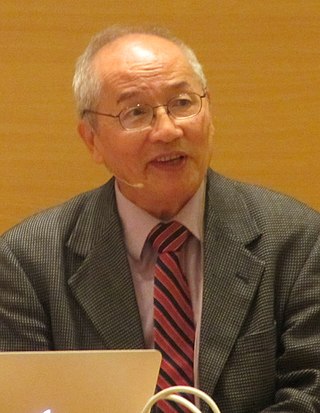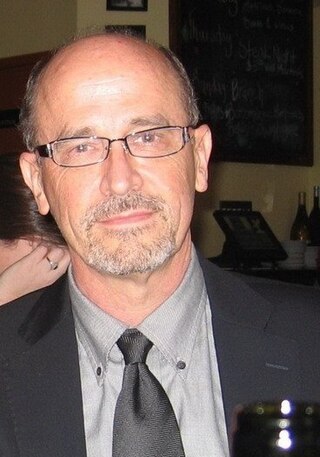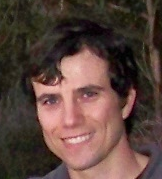Related Research Articles

Sandra Moore Faber is an American astrophysicist known for her research on the evolution of galaxies. She is the University Professor of Astronomy and Astrophysics at the University of California, Santa Cruz, and works at the Lick Observatory. She has made discoveries linking the brightness of galaxies to the speed of stars within them and was the co-discoverer of the Faber–Jackson relation. Faber was also instrumental in designing the Keck telescopes in Hawaii.
Donald Edward Osterbrock was an American astronomer, best known for his work on star formation and on the history of astronomy.

Geoffrey William Marcy is an American astronomer. He was an early influence in the field of exoplanet detection, discovery, and characterization. Marcy was a professor of astronomy at the University of California, Berkeley, and an adjunct professor of physics and astronomy at San Francisco State University. Marcy and his research teams discovered many extrasolar planets, including 70 out of the first 100 known exoplanets and also the first planetary system around a Sun-like star, Upsilon Andromedae. Marcy was a co-investigator on the NASA Kepler space telescope mission. His collaborators have included R. Paul Butler, Debra Fischer and Steven S. Vogt, Jason Wright, Andrew Howard, Katie Peek, John Johnson, Erik Petigura, Lauren Weiss, Lea Hirsch and the Kepler Science Team. Following an investigation for sexual harassment in 2015, Marcy resigned his position at the University of California, Berkeley.

Robert Paul Kraft was an American astronomer. He performed pioneering work on Cepheid variables, stellar rotation, novae, and the chemical evolution of the Milky Way. His name is also associated with the Kraft break: the abrupt change in the average rotation rate of main sequence stars around spectral type F8.

Bryan Malcolm Gaensler is an Australian astronomer based at the University of California, Santa Cruz. He studies magnetars, supernova remnants, and magnetic fields. In 2014, he was appointed as Director of the Dunlap Institute for Astronomy & Astrophysics at the University of Toronto, after James R. Graham's departure. He was the co-chair of the Canadian 2020 Long Range Plan Committee with Pauline Barmby. In 2023, he was appointed as Dean of Physical and Biological Sciences at UC Santa Cruz.

Frank Hsia-San Shu was a Chinese-American astrophysicist, astronomer, and author. He served as a Professor Emeritus at the University of California, Berkeley and University of California, San Diego. He is best known for proposing the density wave theory to explain the structure of spiral galaxies, and for describing a model of star formation, where a giant dense molecular cloud collapses to form a star.

Alexei Vladimir "Alex" Filippenko is an American astrophysicist and professor of astronomy at the University of California, Berkeley. Filippenko graduated from Dos Pueblos High School in Goleta, California. He received a Bachelor of Arts in physics from the University of California, Santa Barbara in 1979 and a Ph.D. in astronomy from the California Institute of Technology in 1984, where he was a Hertz Foundation Fellow. He was a postdoctoral Miller Fellow at Berkeley from 1984 to 1986 and was appointed to Berkeley's faculty in 1986. In 1996 and 2005, he was a Miller Research Professor, and he is currently a Senior Miller Fellow. His research focuses on supernovae and active galaxies at optical, ultraviolet, and near-infrared wavelengths, as well as on black holes, gamma-ray bursts, and the expansion of the Universe.
Stanford Earl Woosley is a physicist, and Professor of Astronomy and Astrophysics. He is the director of the Center for Supernova Research at University of California, Santa Cruz. He has published over 300 papers.

Claire Ellen Max is a Professor of Astronomy and Astrophysics at the University of California, Santa Cruz (UCSC) and is affiliated with the Lick Observatory. She was the Director of the Center for Adaptive Optics at UCSC, 2007-2014. Max received the E.O. Lawrence Award in Physics.

Nicholas B. Suntzeff is an American astronomer and cosmologist. He is a university distinguished professor and holds the Mitchell/Heep/Munnerlyn Chair of Observational Astronomy in the Department of Physics & Astronomy at Texas A&M University where he is director of the Astronomy Program. He is an observational astronomer specializing in cosmology, supernovae, stellar populations, and astronomical instrumentation. With Brian Schmidt he founded the High-z Supernova Search Team, which was honored with the Nobel Prize in Physics in 2011 to Schmidt and Adam Riess.
Wick C. Haxton is an American theoretical nuclear physicist and astrophysicist. He is a professor of physics at the University of California, Berkeley and senior faculty scientist at Lawrence Berkeley National Laboratory. He was appointed a co-editor of the journal Annual Review of Nuclear and Particle Science as of 2023. In 2024, he was elected to the American Philosophical Society.
Jerry Earl Nelson was an American astronomer known for his pioneering work designing segmented mirror telescopes, which led to him sharing the 2010 Kavli Prize for Astrophysics.

Aaron R. Parsons is an American astrophysicist who works primarily in the fields of radio astronomy instrumentation and experimental cosmology.
Douglas N. C. Lin is professor of astronomy and astrophysics at the University of California, Santa Cruz. He was born in New York and grew up in Beijing. He earned his BSc from McGill University, his PhD from the Institute of Astronomy, Cambridge University, and performed postdoctoral research at both Harvard and Cambridge. In 1979 he took an Assistant Professorship at UCSC, and has remained there since. He is also the founding director of the Kavli Institute for Astronomy and Astrophysics at Peking University.

Natalie M. Batalha is professor of Astronomy and Astrophysics at UC Santa Cruz. Previously she was a research astronomer in the Space Sciences Division of NASA Ames Research Center and held the position of Science Team Lead, Mission Scientist, and Project Scientist on the Kepler Mission, the first mission capable of finding Earth-size planets around other stars. Before moving to NASA, Batalha was a Professor of Physics and Astronomy at San Jose State University.
Sarah Dodson-Robinson is an American astronomer known for her work on planet formation and an associate professor of physics and astronomy at the University of Delaware.

Ruth Murray-Clay is a professor at the University of California Santa Cruz who studies the formation of planetary systems.
Jean P. Brodie is a British astrophysicist. She is professor of astronomy and astrophysics at the University of California, Santa Cruz and an astronomer at the Lick Observatory.
Enrico Ramirez-Ruiz is a professor of astronomy and astrophysics at the University of California, Santa Cruz.
References
- ↑ "Mark Krumholz". www.mso.anu.edu.au. Retrieved 2024-10-08.
- ↑ "Mark Krumholz". scholar.google.com. Retrieved 2024-10-08.
- ↑ "A GENERAL THEORY OF TURBULENCE-REGULATED STAR FORMATION, FROM SPIRALS TO ULIRGS". Physics Department, University of California, Berkeley, Berkeley, CA 94720.
- ↑ Hesterman, Donna. "Astronomer Mark Krumholz wins NSF CAREER Award". UC Santa Cruz News. Retrieved 2024-10-08.
- ↑ Stephens, Tim. "Astronomer Mark Krumholz awarded AAS Warner Prize". UC Santa Cruz News. Retrieved 2024-10-08.
- ↑ "Mark Krumholz". www.science.org.au. Retrieved 2024-10-08.